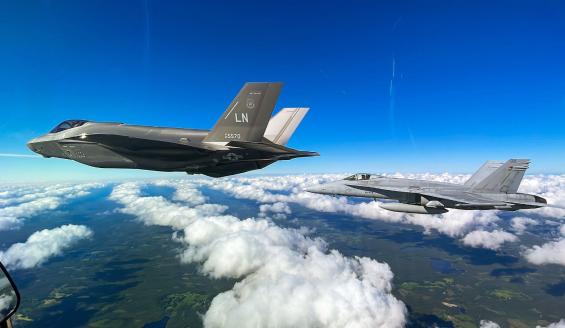From Pilot Reserve Officer Course to F-35 Cockpit
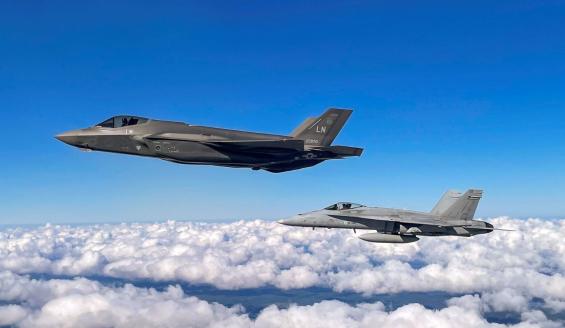
A marked change is on the horizon for the Air Force in the latter half of the decade with the gradual introduction into service of the F-35 fighter aircraft alongside the F/A-18 Hornet and the Hornet’s decommission by the end of 2030. The transition from 4th to 5th generation fighters will also be reflected in the flight training of the Air Force.
The Pilot Reserve Officer Course offers an interesting way to complete military service or voluntary military service for women as studies in, for example, theory of flight and flying a propeller aircraft are included in the course. The course is also the beginning of the study path that leads to the career of an Air Force fighter pilot.
The Air Force study path is more than familiar to Captain Joonas Saukko, currently serving at the Air Force Academy in Tikkakoski. Captain Saukko is the Commander of the 4th Flight of Fighter Squadron 41 and works in the Air Force elementary and basic flight training, i.e. trains conscripts on the Pilot Reserve Officer Course. Saukko also works as an Air Combat Instructor Pilot in the Hawk jet training.
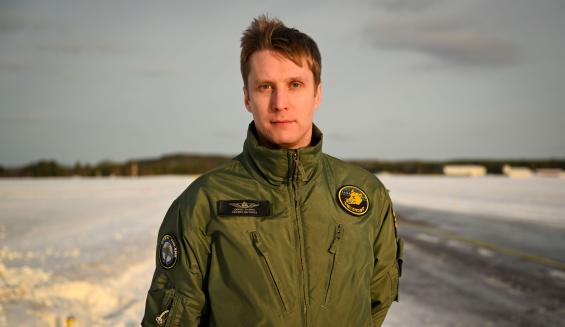
The Air Force Academy is currently running Pilot Reserve Office Course No. 98 with a new batch of reserve officer pilots graduating this summer. Some will continue to Air Force pilot training and some will transfer to the reserve with an unforgettable conscript service in their pockets.
Starting Off on Pilot Reserve Officer Course
Any Finnish citizen liable for military service or seeking to complete voluntary military service may apply to the Pilot Reserve Officer Course, provided they are at least 18 years of age at the onset of the course and no more than 22 the year the course begins. Applications are submitted via the Special Programmes application link. There are specific selection criteria and a selection exam for the course. If an acceptance letter drops into your mailbox after the process, you will have 347 days of conscript service ahead at the Air Force Academy in Tikkakoski near Jyväskylä.
The Pilot Reserve Officer Course is organised once a year and service begins in July with the summer contingent.
– Conscripts accepted into the Pilot Reserve Officer Course start their military service the same way as all conscripts, with learning soldier skills in basic training. During the autumn, the flight theory phase gets underway, meaning theory lessons on (military) aviation, Captain Saukko says.
The Air Force flight training begins with elementary and basic training, where training in flight simulators follows theory lessons. Thanks to simulator training, the principles of controlling an aircraft are learned, so when students start flying, they are already familiar with the basic techniques.
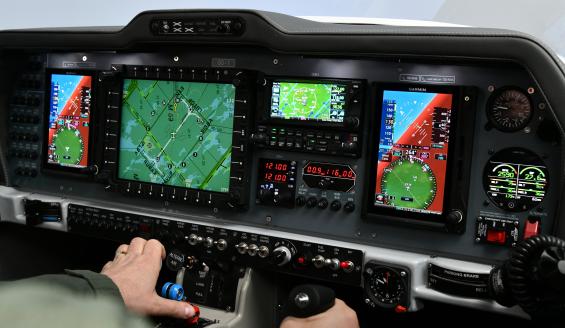
– Students fly their first four flights, at the very least, in a simulator before taking the controls of an actual aircraft. Thus, we can ensure they are basically able to control the plane as they already know the principles of aircraft handling, Saukko describes.
At the turn of the year, about half a year from the onset of their service, the phase the conscripts most anticipate, flight training, begins.
Flight training is flown on the Grob G 115E primary trainer. The Grob is a propeller aircraft with flight characteristics well-suited for elementary flight training.
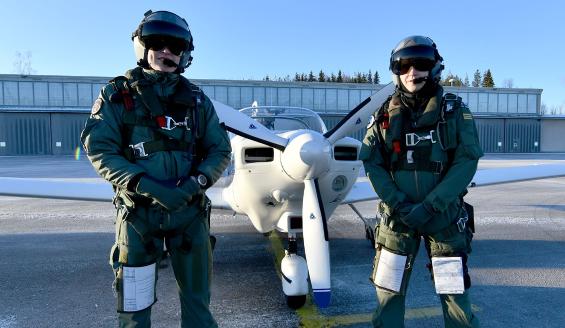
– In elementary flight training, the Grob is used for basic type training flights, and navigation, instrument and aerobatic flights in the end. In practice, this is the very first step where we start off with everyone, Saukko tells.
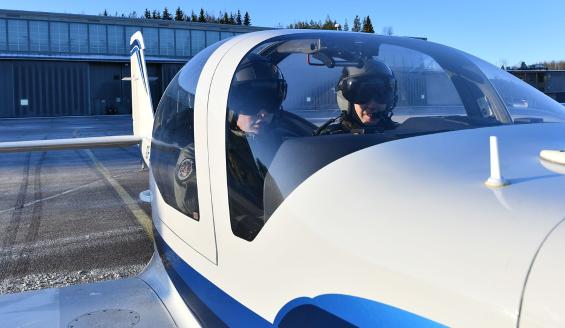
On type training flights all basic aircraft handling skills are covered from departure to arrival. On navigation flights the focus is on navigating with the help of area landmarks, maps and digital systems. The purpose of instrument flights is to learn to fly in low visibility conditions using the information provided by the aircraft displays. Aerobatic training forms the basis for the later phases of Air Force fighter pilot training in which manoeuvres needed in air combat are learned.
Bachelor’s Degree at Cadet School
If conscripts graduating from the Pilot Reserve Officer Course have not yet ingested enough “Vitamin G” and decide to become an Air Force pilot, they will apply via the joint application link to the National Defence University. The bachelor’s degree studies at the National Defence University, or Cadet School, take three years.
For Air Force cadets, flight training resumes on the Grob together with theoretical studies. In the first two years, students practise formation flight and the skills mentioned earlier. The studies will also entail a progression from the principles of flying to the basics of military aviation tactics.

In the final year of the Cadet School, Air Force cadets advance to the type training phase on jet trainers, which in the Air Force means transitioning from the Grob trainers to the Hawk Mk 51 and Mk 66 jet trainers.

– On the Hawk jet trainer, we also start with type training flights, learning how to fly the plane and control it, and after that we move on to the tactical phase, Captain Saukko describes.
After the three-year bachelor’s programme, cadets graduate, they are promoted to lieutenants, and they enter working life in the Defence Forces as fresh officers. The Air Force cadets studying to become pilots continue directly to their master’s after graduating as bachelors. The studies include all the academic courses and flight training required for the Master’s in Military Sciences degree.

Flight training continues during the master’s programme with the tactical phase. In the tactical phase, students learn to operate the jet trainer in all weather and lighting conditions, and to fly in challenging operational environments where they must consider the threat of an adversary and other aircraft in the air. The aim of the tactical phase is to achieve the objectives set for each mission regardless of the meteorological conditions and threat level.
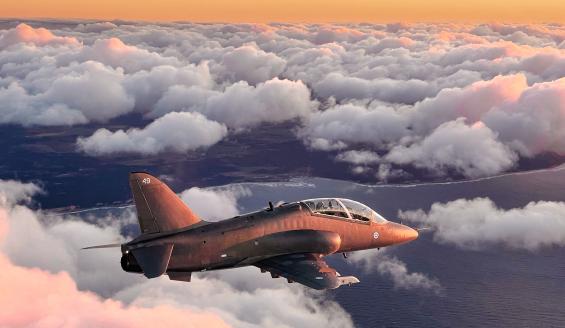
According to the current programme, students fly on the Hawk for altogether three years - one as a cadet and two during the master’s, after which they transition to the multi-role fighter.
As Master’s Student into Cockpit of Multi-Role Fighter
When students have three years of flying on the Grob primary trainer and three years on the Hawk jet trainer under their belts, they will attain the objective of operating a multi-role fighter. Current Pilot Reserve Officer Course students are likely to reach the F-35 controls directly if they decide to continue in the Air Force pilot training.
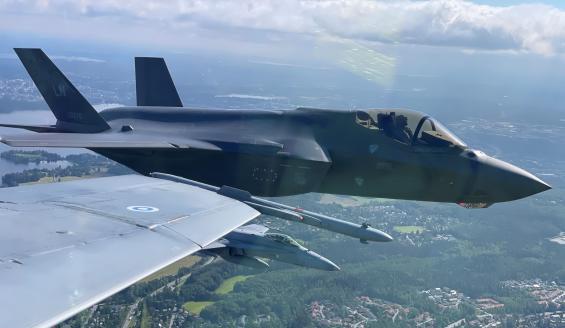
If for example a student now on the Pilot Reserve Officer Course were to be selected in this spring’s joint application process to study at the National Defence University as an Air Force pilot cadet and began their studies this autumn, they would be a third-year cadet in the autumn of 2026 and about to start training on the Hawk fleet. With studies and training progressing as planned, it would be time to enter the fighter jet phase around the time the F-35 integration is in full swing. The first F-35 fighter aircraft will arrive in Finland at Lapland Air Wing in the year 2026 and the current F/A-18 fleet is to remain in service until the end of 2030, so during the transition, the Air Force will operate both 4th and 5th generation fighters.
Simulator’s Role in Training to Increase
Flight simulators are utilised in the Air Force pilot training in an effective and versatile way from the beginning of flight studies. In the simulators, the basic operation of an aircraft is practised before flying an actual aircraft. Apart from basic skills, demanding manoeuvres and missions can be trained even in the simulator, so that flying an aircraft can be started from more challenging training scenarios. In each phase of flight training, simulator training always precedes transitions to new categories of flying, bringing new elements to a mission, or starting to fly more demanding aircraft.
The farther the Air Force pilot training advances, the more versatile the flight simulators become.
– The simulator world on the Hawk side is slightly richer, and LVC elements can be added to it, which involves creating virtual and constructive targets alongside real aeroplanes to fight with them, Captain Saukko tells.

LVC (Live, Virtual, and Constructive) means that in one mission, operations can be executed not only by actual aircraft but also simulators, virtual aircraft, and other elements created in the mission environment. LVC elements can be added on both the friendly and adversary sides, which makes training big and diverse missions and air operations feasible and cost-effective when all aircraft need not in reality be airborne.
The importance of simulators in flight training will only grow when the Air Force transitions from the Hornet fleet to the F-35 fighters. As the simulators and constructive elements on the LVC network are not visible to external users, the LVC environment also allows training of F-35 tasks that are kept secret from unauthorised persons. In addition, the F-35 is a single-seat aircraft, so one’s first flight on the F-35 is also one’s first solo flight.

F-35 Era to Be Reflected in Education and Training
A 5th generation fighter, the F-35 will bring along technological differences to the 4th generation F/A-18. The F-35 is a modern and software-based fighter aircraft; hence, an interest shown towards information technology is an asset when learning to operate it.
The F-35 is also technologically advanced due to its effective sensor fusion, among other features. Sensor fusion refers to the F-35 collecting data from its surroundings with different sensors, such as radars, and fusing, or combining, and compiling it and presenting the information collected to the pilot on the cockpit screens and helmet-mounted display system. The information collected and provided by the fighter creates situational awareness for the pilot to support decision-making. The mechanical control of the F-35 has been made so effortless that the pilot has a better chance than before to focus on using the diverse data provided by the aircraft for conducting the mission.
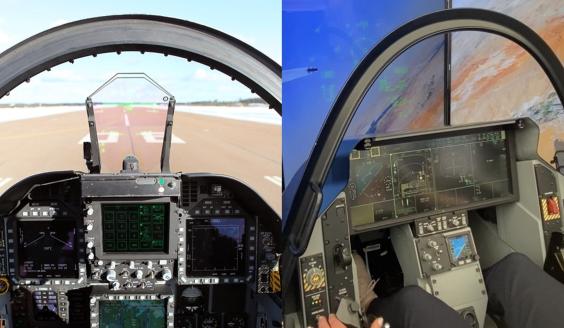
The Air Force flight training programme is already being updated for the F-35 era. Elements required for flying the F-35 are being added even to the elementary as well as the jet type training phase. Efforts have been made to introduce technical solutions that resemble operating the F-35. For example, simulated weapons and radar can be utilised to train air combat beyond visual range, which is one of the key tasks of fighter aircraft.
Another example of the preparation for the F-35 era is the Grob primary trainer’s considerably modern equipped cockpit with spices hinting at the F-35. In the cockpit, for example some of the displays are touch screens that not all propeller planes similar to the Grob have to this extent. The modern cockpit with its screens offers a glimpse of the F-35 features. The F-35 cockpit consists, in essence, of touch screens on which the pilot can choose to display the information that is key for mission completion.
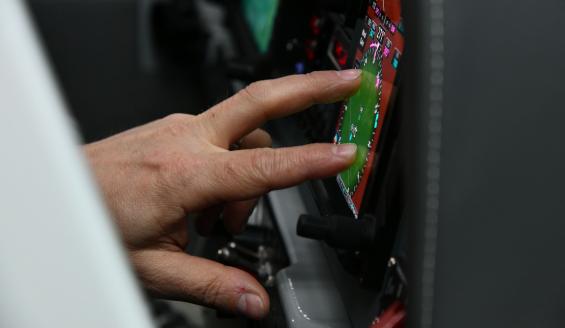
In addition, a more comprehensive approach to understanding missions has been added to the Air Force pilot training, stemming from the F-35’s wide scope of missions. The F-35 can execute diverse mission types, the most important of which are air combat, land- and surface warfare support, long-range strikes, or firing at long-distance targets, and reconnaissance and sharing the situation picture. The F-35’s sensors, such as different radar systems, can collect and compile a variety of information from the operational environment for the use of the Air Force as well as the Army and Navy. As a new feature for the Air Force, the F-35 brings an electronic attack capability, for example, jamming enemy radars so they cannot function normally.
– Internationally speaking, the Air Force pilot training is on a high level and we do a great job already from the get-go. The path from the Pilot Reserve Officer Course to an F-35 pilot is truly demanding and well-rounded. The learning curve is steep but manageable. We instructors do our best to ensure that each student who enrolls with us becomes the best pilot possible, Captain Saukko sums up.
Are you interested in the career of an Air Force pilot? Read more at: Pilots - Intti.fi
